Engine Invaders: How To Keep Pack Rats Out of Your Car
With the desert climate starting to cool off at night in states like Arizona, there’s a new pest to look out for — pack rats. But unlike most pests, your home isn’t the most likely place you’ll find one.
While most mice look to get indoors during the winter, these rodents are infamous for seeking shelter under car hoods. Letting these furry critters hole up in your engine for a few nights may sound harmless, but that couldn’t be further from the truth. If you’d like to avoid an expensive repair bill, use this guide to help your car survive pack rat season in Arizona.
Why Pack Rats Target Your Engine
Also known as wood rats, pack rats are nocturnal rodents that gather and hoard items to build nests. They’re attracted to warm, dark spaces, and an engine bay provides the perfect shelter during chilly nights. Besides warmth, your car may also offer a supply of leaves and twigs, which pack rats will use to build their nests.
Unfortunately, a pack rat making a cozy hideaway in your car is the least of your worries. That’s because these rodents don’t just camp out — they chew through wiring, hoses, and insulation, damaging your car and making it unsafe to drive.
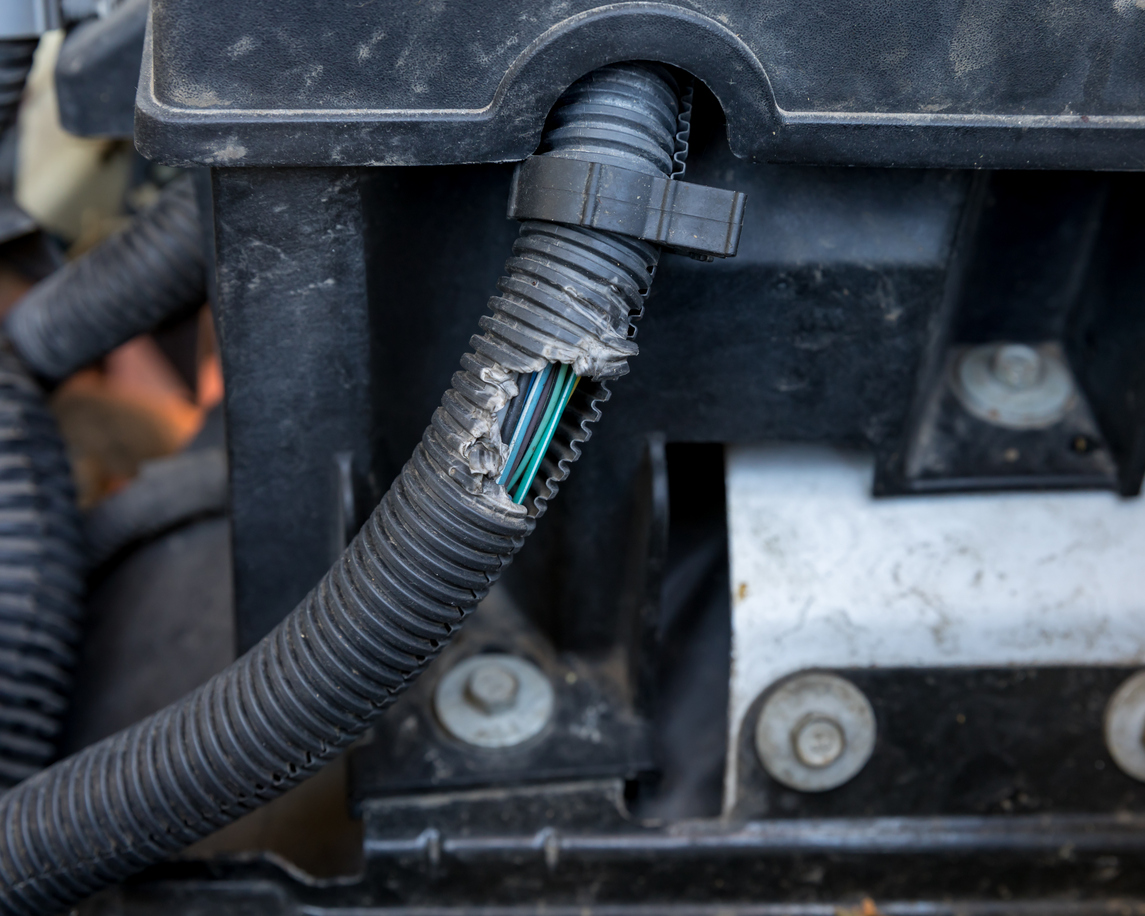
The Destruction Pack Rats Can Cause
If you don’t trust mechanics, a pack rat is the last one you want under your hood.
Like most mice and rats, pack rats chew and gnaw on almost anything they can get their mouths on. With all the wires and hoses under your car hood, an engine bay is like a charcuterie board for a pack rat.
For an appetizer, they may gnaw on electrical wiring, sometimes attracted to the soy-based coating that many manufacturers use. This type of damage can lead to anything from malfunctioning lights to total engine failure. They may also chew through hoses, which can result in fluid leaks that compromise your vehicle’s performance. Brake lines and coolant hoses are especially vulnerable, and any damage to these can pose a serious safety risk.
As they search for nesting materials, pack rats often tear apart insulation or even parts of the air filters. This can lead to reduced airflow in your engine or even fires if debris comes into contact with hot engine parts. Occasionally, pack rats also target battery cables, which can result in short circuits or a vehicle that’s unable to start.
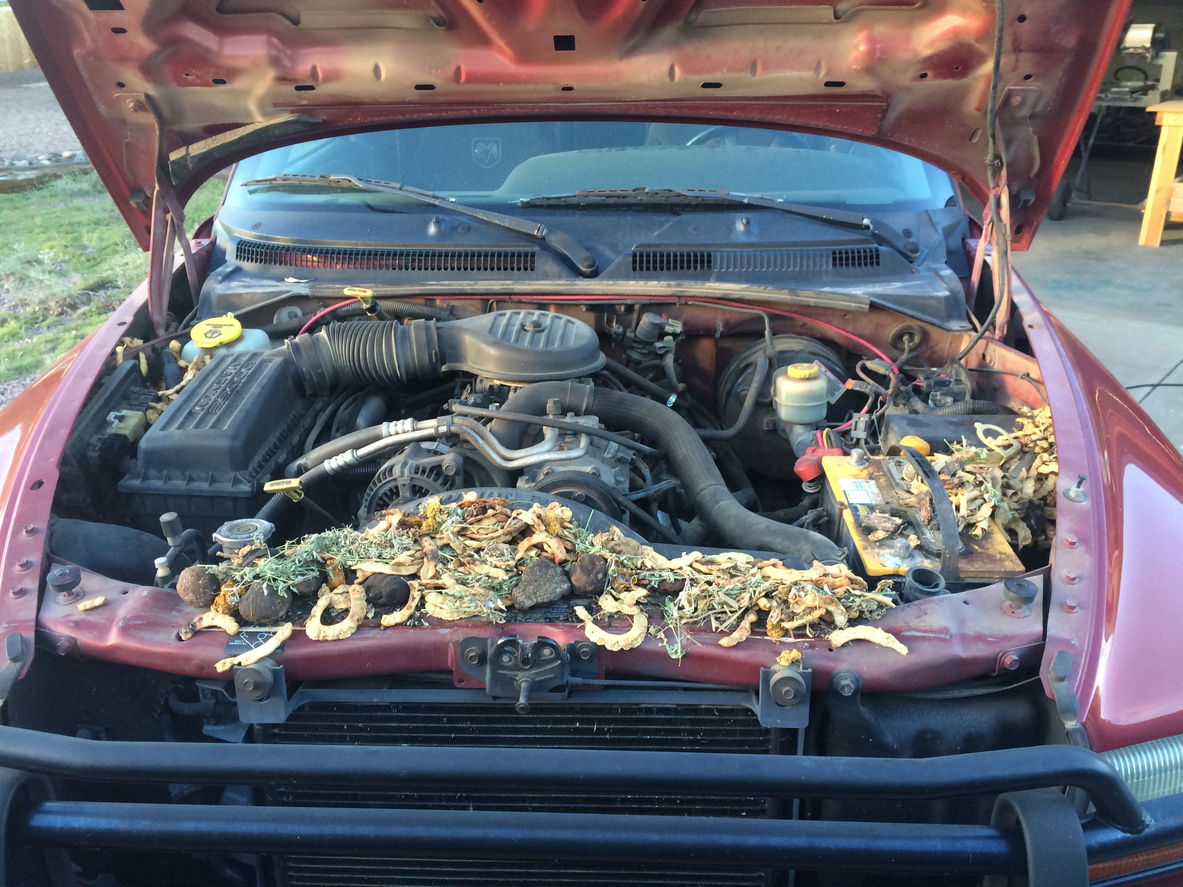
Signs of a Pack Rat Infestation in Your Vehicle
If a high repair bill isn’t in your budget, being able to recognize when a pack rat is under your hood is key.
As pack rats start to settle in, it can be hard to spot them, but there are still some telltale signs. Strong odors, particularly from droppings or urine, are often a dead giveaway. If you’re suspicious of what you’re smelling, check around or inside your engine bay for droppings or bits of debris. If you see leaves and twigs in places they aren’t supposed to be, it’s a good indicator a pack rat is setting up camp.
Of course, if a pack rat has settled in for a few days, the signs are more obvious. Chewed wires, hoses, or other visible gnawing damage means you’ve picked up a hitchhiker. You may also hear strange noises coming from your car while driving.
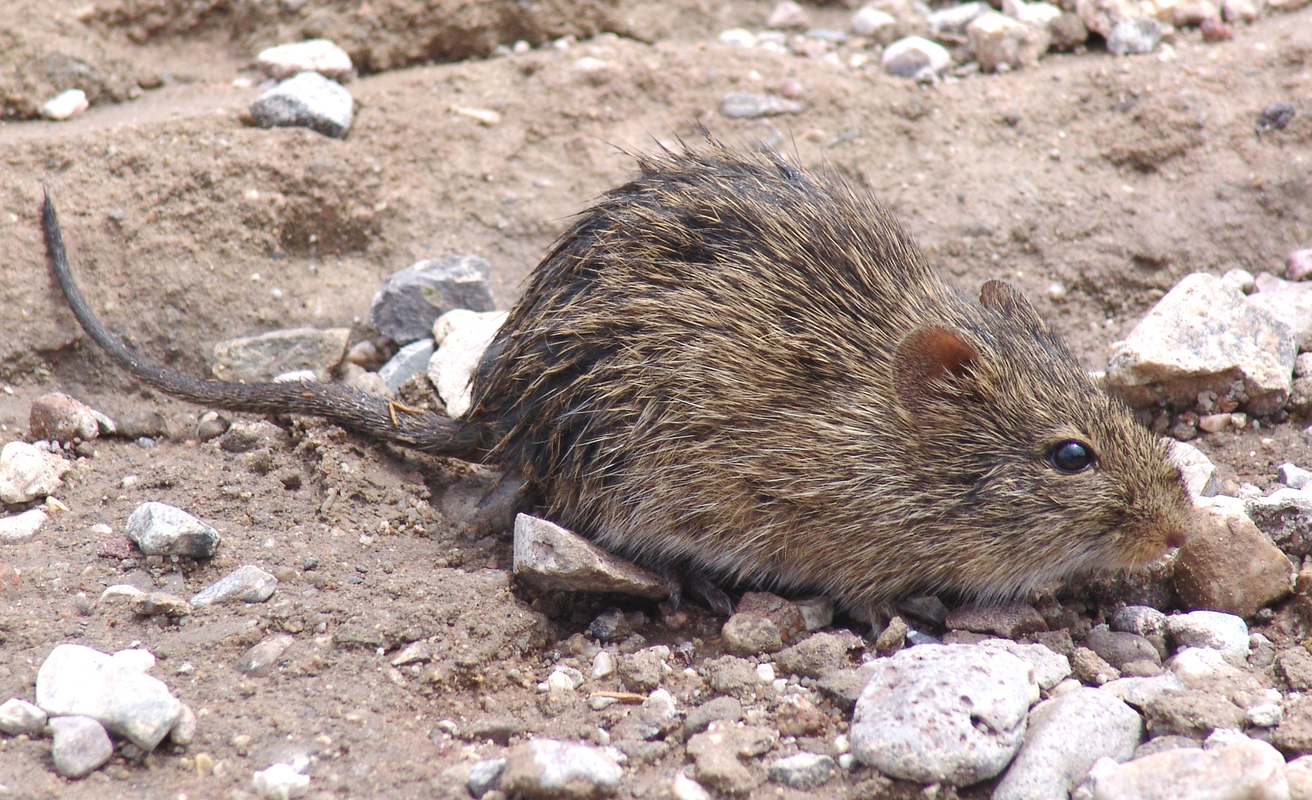
How To Keep Pack Rats Out of Your Car
By getting ahead of pack rats, you can reduce the chances one will make your car its new home.
1. Assess Your Parking Situation
Parking in a closed garage adds an extra layer of defense, making it much harder for a pack rat to get into your vehicle. If that isn’t an option, there are ways to keep the area where you park outside more secure.
2. Eliminate Food Sources
Avoid leaving any food or trash in or near your parked vehicle, as pack rats are naturally attracted to food sources. It’s also a good idea to park away from trash cans to reduce the chances of drawing a pack rat near your vehicle.
3. Use Lighting to Your Advantage
Since pack rats are nocturnal, consider leaving a light on under or near your car at night. The brightness can discourage them from making a cozy home in your engine bay.
4. Rodent-Proof Your Garage
If your garage itself has a rodent problem, setting traps or using deterrents can also help keep pack rats away. Natural scents like peppermint oil, cayenne pepper, and garlic are a good place to start. Spraying these scents around the engine bay or placing pouches with these odors near your parked car can deter pack rats effectively.
5. Look Under the Hood
To catch a pack rat infestation before it begins, make it a habit to inspect your engine bay regularly, especially during colder months when pack rats are more likely to seek shelter. Checking under the hood every few days can help you catch any early signs of rodent activity and prevent damage.
6. Protect Wires and Hoses
If you’d like to be extra cautious, consider wrapping wires and hoses in rodent-resistant tape. This special tape has a coating that can deter rodents from chewing through it and protect vital parts of your car.
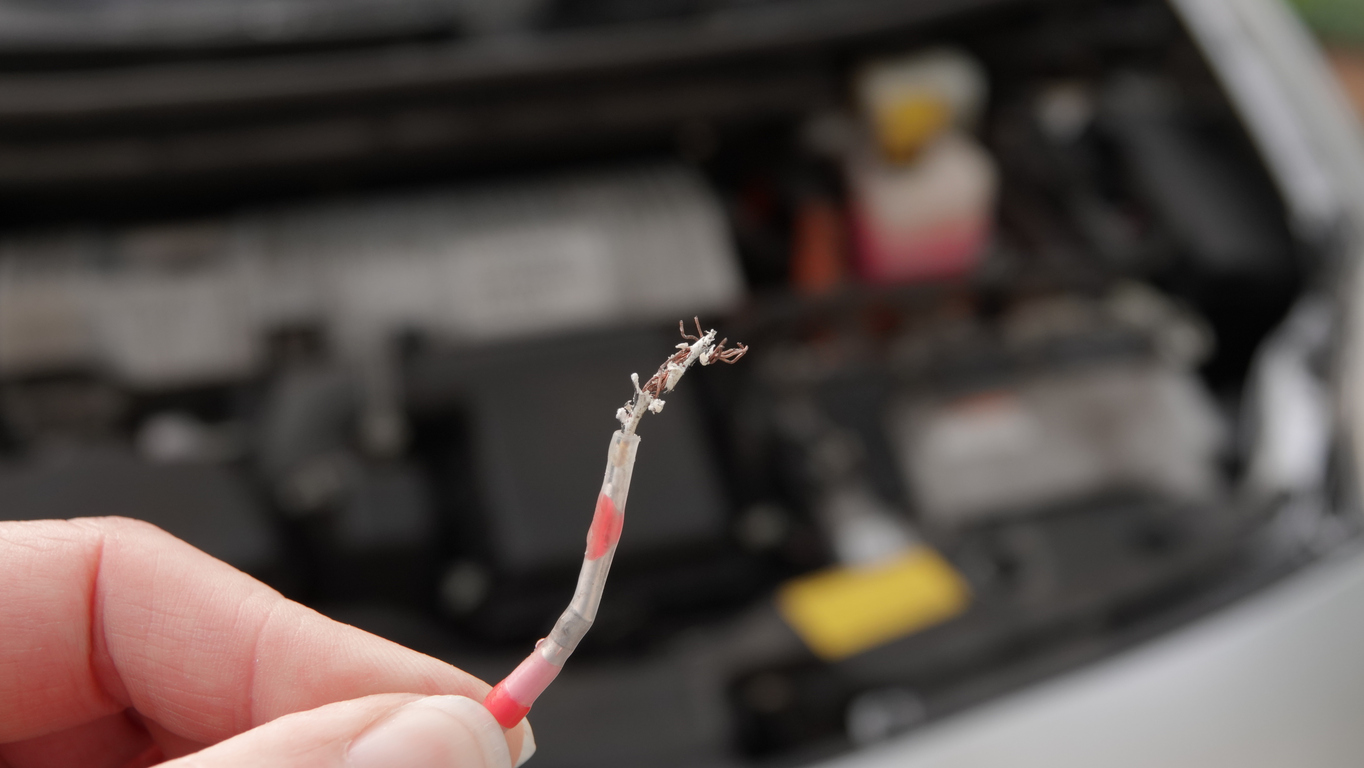
What To Do if You Find a Pack Rat in Your Car
Whether you see the pack rat or just find signs of one, it’s essential to address the problem immediately. Start by removing any nesting materials you find and clean the area. Take extra precautions by wearing gloves so you don’t come into contact with any droppings or urine. If you find chewed wires or any other signs of damage, take your car to be inspected by a professional.
Send Pack Rats Packing
Are pesky pack rats driving you crazy? Whether you’re dealing with an infestation under your hood or in your home, contact us for a quick and efficient removal.
How to Get Rid of Rats in Your Car Engine like a Pro

Rats are some of the craftiest pests around—able to eat almost anything and live anywhere, including your car engine. If the idea of finding a rat under your hood sounds horrifying, just imagine the damage they could do. But don’t worry! In this guide, we’ll share our top field-tested techniques to help you eliminate rats from your engine for good.
Key Takeaways
- To get rid of rats in your car engine, you can clean and sanitize the engine, remove nests and waste, use rodent repellent spray, set traps around your property, and maintain a clean yard to deter them.
- Rats will seek shelter and warmth in car engines, especially if the car doesn’t get driven much or is parked in a rodent-infested area.
- Never use a power washer to remove rodents from your car engine, as the force of the water could spread nest material and contaminate urine and feces everywhere.
- If the rodents are living in an area of the engine you can’t see or reach, you may need to contact a professional pest management company for help.
What Damage do Rats Cause to Cars?
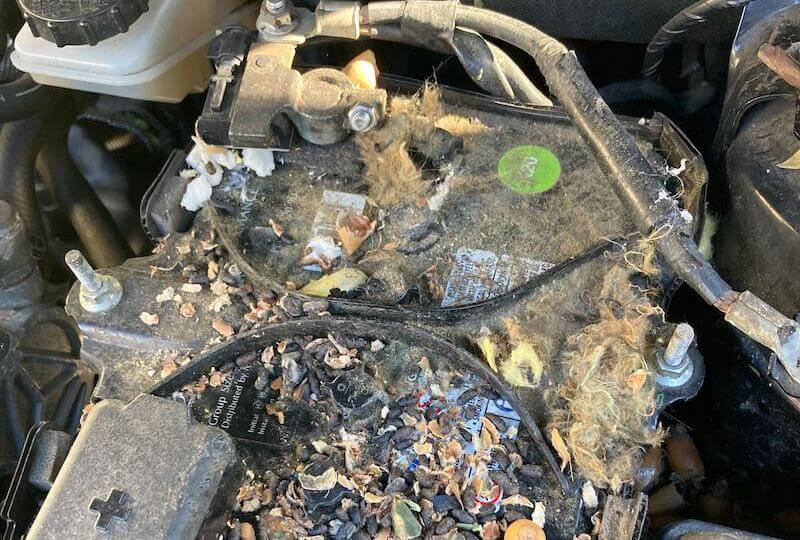
Rats will pack the cavities of your car’s engine with nesting materials like shredded paper, organic materials, and sticks.
Over time, this can block critical engine components or create fire hazards.
Once they’ve created a cozy home in your engine, rats will gnaw on the wires and hoses surrounding them.
They don’t chew wires because they’re hungry:
They do it to gather more nesting material or to keep their ever-growing teeth trimmed.
Unfortunately, all that gnawing can blow fuses, start fires, or even destroy your car’s engine.
“We once had a customer show us their $2800 bill from the mechanic after taking their Ford pickup in for repairs.
The rats had eaten so much insulation off the wires, there were short circuits causing the vehicle to be inoperable.” – Zachary Smith, “The Pest Dude’
Don’t let this happen to your car!
Moreover, if rats die in your engine, their decomposing bodies will create a stench that travels into your car’s cabin through the HVAC system, making your heating and air conditioning impossible or unpleasant to use.
Before You Get Started
Before you begin, gather these supplies:
1. Full Face Respirator
Rats carry hantavirus, which can cause hantavirus pulmonary syndrome (HPS) in humans who encounter infected rat feces or urine.
As such, it’s critical to wear personal protective equipment (PPE) when getting rid of rats.
A full-face respirator will protect you from inhaling airborne viruses and other rat-borne irritants.
2. Gloves
Wear gloves like these to protect your hands from injury and avoid contact with rat feces, urine, or nesting material during removal.
3. Rodent Repellent Spray
This outdoor rodent repellent spray is 100% natural and designed to keep rats from re-entering your car engine once you’ve cleaned it out.
4. Weighted Car Cover
Create a rodent-proof barrier around your car with a weighted car cover.
The cover sits flush with the ground to create a rodent-resistant barrier that rats can’t penetrate.
5. T Rex Snap Traps
Setting rat traps around your yard, garage, and property will reduce rat populations and prevent re-infestation.
Zachary Smith, the owner of Pest Dude and a licensed pest removal professional, relies on these T-Rex plastic rat traps for two reasons.
First, they’re easy to set, and second, they have a superior design that allows them to be easily triggered by foraging rats.
We recommend baiting them with peanut butter, Snickers bars, beef jerky, cheese whiz, or bacon for best results.
If you want to try a different trap, check out our guide on the best rat traps.
5 Steps to Get Rid of Rats in Your Car Engine Quickly
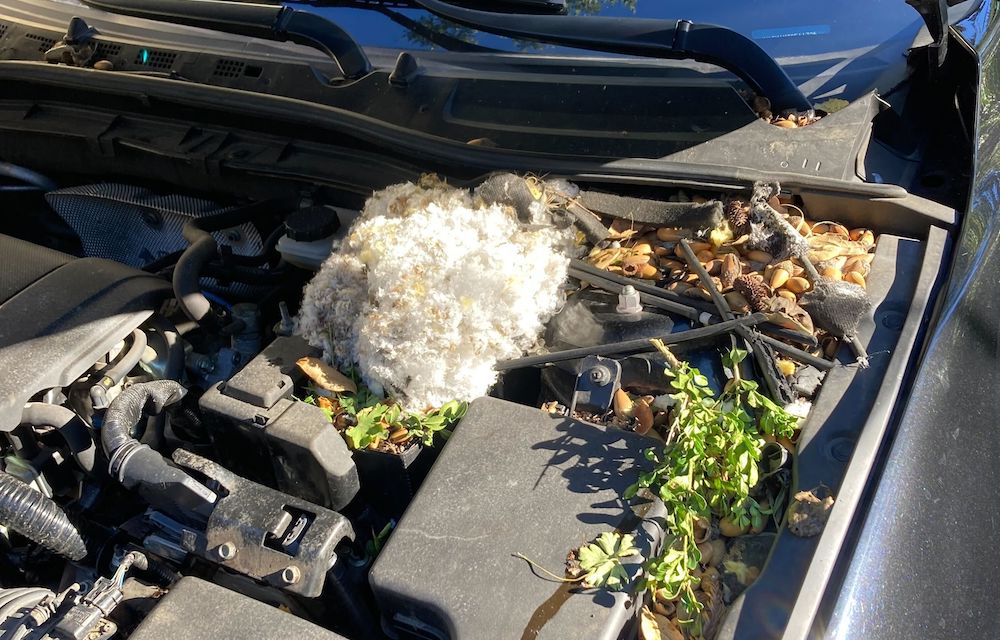
1. Air Out Your Car
Open the car’s hood, doors, and trunk to let the vehicle air out for about 20 minutes before you begin.
This helps clear out dangerous airborne contaminants and reduces your chance of encountering hantavirus.
2. Inspect Your Engine for Rats
Before evicting rats and their nests, you must figure out where they live.
As such, the next step is to conduct a thorough inspection of the vehicle’s interior and engine.
Remove the cables from the battery to avoid shock before inspecting the engine, including all air intakes and filters.
Identify and make a note of all nests and areas of rat activity.
3. Disinfect the Engine
Once you’ve pinpointed living or dead rodents, nesting materials, and rodent waste, gather your cleaning supplies to clean and disinfect the engine.
Here’s the process the CDC recommends:
- Spray all affected areas with a CDC-approved disinfectant until they’re thoroughly soaked. Allow the disinfectant to sit for 5 minutes.
- Wearing rubber or plastic gloves, use a paper towel to pick up and remove all nesting materials. Dispose of them in a sealed plastic bag. If nesting materials are present in the air intake system, remove the air filter and the nesting materials. Discard both in the garbage before inserting a clean replacement filter and closing the air intake unit.
- Once you’ve sprayed disinfectant on the affected areas, you can use a shop vac to remove rodent urine, droppings, and nest material.
- Once you’ve removed all the nesting materials, clean the rest of the affected area with additional disinfectant.
- Allow the area to dry thoroughly for 60-90 minutes.
- Once the engine is dry, reconnect the battery.
- When you’ve finished disinfecting the area, wash your gloved hands with hot, soapy water. Remove the clean gloves and wash your bare hands with hot, soapy water.
4. Apply a Non-Flammable Repellent

Once you’ve disinfected your engine and removed all nesting materials, spray the engine with a non-flammable rodent repellent like this one or apply a repellent gel (we like this one).
The repellent will make your engine unattractive to rodents and help deter them from returning.
5. Clean Up the Yard
Next, turn your attention to the space around your car.
We recommend cleaning up your yard to make it unattractive to rodents.
Here are a few tips:
- Clean up all debris piles and anything that could provide shelter to rats, including piles of recycling or cardboard boxes, old appliances, and wood piles.
- Remove rat food sources, including fruits, nuts, acorns, pet food, and human scraps. If you have snails in your yard, consider investing in a professional snail treatment since these mollusks are a rat’s favorite food.
- Introduce natural predators to your yard by building an owl box or letting pet dogs and cats out into the yard more frequently.
Here’s another tip from the Pest Dude:
“Apply heavy and repeated repellent spray to the engine bay, as well as trapping and baiting all around the property to reduce the rats.
Leave the hood open to let more daylight in. Rats hate daylight!
The problem will go away with regular preventative repellent spray and population reduction.” – Zachary Smith, “The Pest Dude”
Methods to Avoid
Whatever you do, stay away from these unproven methods:
Mothballs
Sure, they might seem like a quick fix, but mothballs are toxic, and the fumes they emit can be harmful to you and your passengers.
Placing Poison Near Your Engine
Poison might seem like a solution, but it’s dangerous for pets and wildlife and can create a hazard for your family and kids.
Sticky Traps
Sticky traps might catch more than you bargained for—like pets or non-target species.
Spraying Water in the Engine
Spraying water to flush out rats or debris will likely damage sensitive engine components, leading to expensive repairs.
Flammable Repellents
Flammable sprays or repellents are just a terrible idea around a hot engine.
The risk of starting a fire just isn’t worth it!
Catching Rats by Hand
Catching a rat by hand is dangerous and unsafe.
Rats can bite and carry diseases—so it’s definitely not worth the risk.
Used Cat Litter
Used cat litter might sound clever, but it often attracts other pests and leaves your car smelling awful.
Blocking Ventilation Holes
Blocking ventilation holes might seem like a way to keep rats out, but this can cause your engine to overheat, leading to bigger problems.
Household Cleaners
Household cleaners aren’t made for engine components and can cause damage.
Stick to products specifically designed for cars.
Ultrasonic Devices
These devices claim to repel rodents using sound, but they rarely work.
Tips to Prevent Rats From Coming Back

Now that you’ve dealt with your rat infestation, keep the pests from coming back with these tips:
- Keep your car covered with a weighted coverlike this one, especially if you won’t be using it for an extended period.
- Maintain your vehicle correctly – remember that rats can easily enter your vehicle’s cabin through ducts, rusted areas, and cable conduits. Have any potential access points patched or sealed by a mechanic.
- Do not leave any kind of food or drinks in the car since they can attract rodents.
- Re-apply rodent repellent every three months.
- Avoid parking your car in areas known to attract rodents, like alleys near trash bins or near natural food sources, like vegetable gardens.
- Keep your car in a closed garage whenever possible.
- Never leave your car’s doors or windows open when the car is not in use.
- Move parked cars regularly to deter rodent activity.
When to Call in the Pros
Sometimes, a rat problem is just too big for DIY fixes.
If you’ve tried everything and the rodents are still hanging around, it might be time to call the experts.
Here are some signs it’s time to get help:
- Constant scratching or scurrying sounds
- Finding multiple nests or lots of droppings
- Spotting chewed wires and damage to your car’s engine
Pros have the right tools and know-how to handle the problem safely and effectively.
Plus, they can help you rodent-proof your space to keep the rats from coming back.
Looking for an Exterminator? We Can Help!
You don’t have to live with rats in your car engine forever. Our experienced team is here to help!
If your DIY rat removal attempts have failed, or you’ve run out of options, it’s best to contact a reputable, local pest control company in your area.
Fortunately, we have a broad network of reputable partners in your area.
https://www.arrowexterminators.com/learning-center/blog/engine-invaders-how-to-keep-pack-rats-out-of-your-car
https://pestdude.com/how-to-get-rid-of-rats-in-car-engine/
